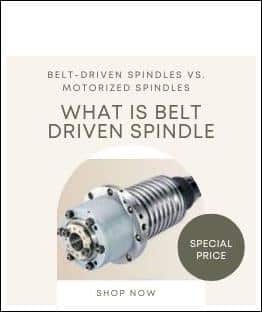
Not every spindle is created exactly the same. They have common features, such as a high-speed spindle, a motor, bearings, a tool holder, and an operator. However, when it comes to the types of spindles that are out there, the choices usually boil down to two: belt-driven or motorized types.
Which leads to the inevitable question: which type of spindle should you choose for your needs?
The obvious answer is, “It depends.” But that’s also a very true answer. The choice always depends on what you need the spindle for. Is it for hobby work or high-speed machining of precision parts? Are you working with wood or alloys and metals? Do you have a lot of space to work in, or is your work area confined to certain limits?
This is all to say that your choice of belt-driven spindles or motorized spindles will ultimately boil down to what you want to achieve with them. That being said, some pros and cons come with both types of spindles. Let’s take a closer look at the pros and cons to see if we can help make your decision that much easier.
The Difference Between a Belt-Driven and Motorized Spindle
As mentioned above, a common feature among all spindles is the presence of a motor. If there’s no motor, there will be no high-speed rotation. So, if motors are common, what makes these two types so different?
As the name implies, belt-driven spindles utilize a belt-and-pulley design to act as the transmission as opposed to any other coupling or gearing design. In addition, belt-driven spindles, because they utilize a belt-and-pulley design, have their motors separate from the spindle assembly.
Motorized spindles, on the other hand, have their motors coupled with the spindle assembly. This allows the total spindle unit design to be more compact and efficient regarding the required space.
Belt-Driven Spindles: Pros and Cons
Again, your choice of spindles will ultimately come down to several factors, including cost, needs, and space. Below are the pros and cons we feel are important in addressing spindles.
Pros
- Versatile. Belt-driven spindles generate less power and torque compared to motorized spindles, making them more versatile for a wide range of operations that don’t require as much speed or torque. This makes them ideally suited for smaller operations or hobbyists that aren’t manufacturing high-precision products or working with tougher materials. That being said, if you have a big enough space, you can up the size of your motor if you need more torque for a belt-driven spindle.
- Cost. Belt-driven spindles are cheaper than motorized ones, making them a solid choice for lower-budget operations or for someone starting out working with spindles. This isn’t to say they’re cheaply made. Rather, belt-driven spindles are simple in design and more affordable to make and customize.
- Easy to Maintain. Because they’re simple in design, belt-driven spindles are also easier to maintain and repair. Their repair parts are readily available and easy to stock. In addition, the fact that the motor is separate from the spindle unit makes any work on the motor easier and cheaper compared to motorized spindles.
Cons
- Slower. There’s no getting around the fact that belt-driven spindles are slower than their motorized cousins, usually reaching speeds up to 6000 RPM.
- Less Power. Again, because of their design, belt-driven spindles can’t match the power output motorized spindles can achieve in a much smaller space.
- Less Efficient. The fact that the motor for a belt-driven spindle is off-mounted results in less efficient work compared to motorized spindles. This isn’t a big deal if you’re doing work requiring less speed and torque in the first place. However, if you need highly precise products made fast, efficiently, and repeatedly, belt-driven spindles are probably not the best choice.
Motorized Spindles
Before getting into the pros and cons of motorized spindles, let’s take a quick look at the two types of motorized spindles out there. Yes, there are technically two types. These are known as direct drive spindles and integral motor spindles. Both, though, have their motors directly coupled to the spindle shaft, forming a single spindle unit or assembly. The main difference between them is that the integral motor spindle sits within a single encased housing and operates at much faster speeds than direct drive spindles. Integral motor spindles are also the most common type of precision spindles used in high-speed CNC machine manufacturing.
Pros
- Fast. Because of their design, motorized spindles can reach very high speeds. Direct drive spindles can reach speeds up to 36,000 RPM, while integral motor spindles can surpass 60,000 RPM.
- Efficient. The compact design of motorized spindles requires less space than belt-driven spindles while achieving higher speeds and precision.
- Low Vibrations. Coupling the motor to the spindle shaft and eliminating the belt-and-pulley design naturally reduces vibrations within the spindle unit.
- Precise. If you have an operation that makes or will make high-precision parts or components, you won’t find a more precise spindle than a motorized one.
Cons
- Cost. With high speeds, efficiency, and precision comes higher costs. That includes the initial upfront costs as well as maintenance. In addition, replacing parts could lead to operational downtime and rework if damage occurs.
- Maintenance Intensive. This doesn’t mean motorized spindles break all the time. Due to their design and workload, they require more maintenance, especially preventive maintenance.
- Training. Operators and technicians who work with motorized spindles require more specialized training than a video or owner’s manual can provide.
In Conclusion
Both belt-driven and motorized spindles have their fair share of pros and cons. However, when it comes to deciding which one is right for you, the choice will likely come down to what fits your needs, the type of work you’re doing, and how much you’re willing to spend.
Leave a Reply
You must be logged in to post a comment.